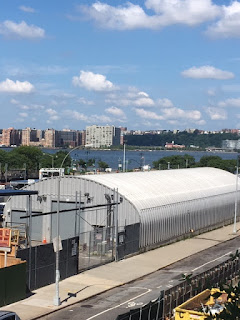The New
York City High Line, a 1.45-mile elevated walkway bordered by over five hundred
species of plants and trees, is a public park built on a historic elevated
freight train line on Manhattan’s West Side. Neighborhood residents and the
City of New York saved the rail line from demolition in the early 2000s,
envisioning a public space celebrating nature, art, and design.
Inspired
by twenty-five years of a self-seeded landscape on the train tracks, garden
designers selected perennials, grasses, shrubs, and trees appropriate for life
in the irrigated planting beds that would attract birds and insects. The plants
are left standing all winter, with a large volunteer force cutting them back in
March.
Various art installations line the walkways.
We walked
the High Line one hot summer morning, catching glimpses of the Hudson River as we
strolled south. Traffic noise was muted. People were free to amble and rest on
benches. I saw city birds—English sparrows and pigeons—though I suspect more
species live in the gardens. The planting beds are six to ten feet deep on
either side of concrete paver stones. Rain water is captured in the cracks
between the stones, and flows into the planting beds. Perennials, which are
hybridized prairie wildflowers, bloom in a carefully orchestrated sequence. When
we visited the third week of July, coneflowers, the last of the liatris,
various sunflowers, and brown-eyed Susans bloomed next to sprawling
blue-flowered wild petunias. At the southern end of the high line, an
established stand of marsh mallow showed extravagant pink flowers against the
tall buildings along the river.
A High
Line Network exists, with projects underway or complete in 2019: the 11th
Street Bridge Park in Washington D.C.; the Presidio Tunnel Tops in San
Francisco; the Atlanta BeltLine; the Queensway in the Borough of Queens; River
LA in Los Angeles; Buffalo Bayou Project in Houston; and the Dequindre Cut in
Detroit.
Readers
and writers, do you have a High Line project in your area or have you visited
one?

















Great pictures! Anything we can do in the old urban landscapes, which have paved over so much of the land, to encourage appropriate wildlife is great.
ReplyDeleteSome old railroad right-of-ways have been made into hiking and bike trails, somewhat to the dismay of property owners. In many cases, the original right-of-way agreement stated that if the railroad line were abandoned, the property would revert to the original landowner, but that's not what's happening.
Thanks, Margaret, for the information and photos of the High Line. I've been reading more and more about it recently and it intrigues me. Would love to see it.
ReplyDeleteWhat a wonderful idea to reclaim more green space in the city. Great photos to go with your thoughts!
ReplyDeleteIngenious re-purposing!
ReplyDeleteWonderful photos, Margaret. Thank you for sharing them, and for giving them context with such interesting details.
ReplyDeleteI love the artwork, too. Just looking at these photos, you can feel the creative energy!